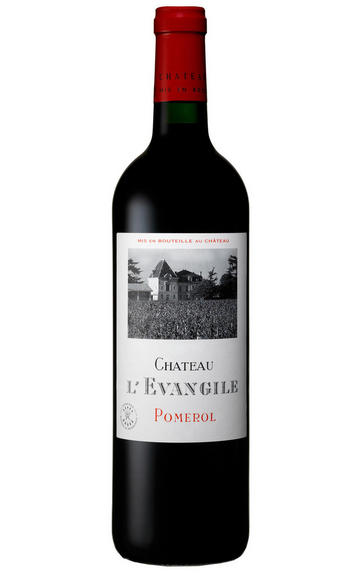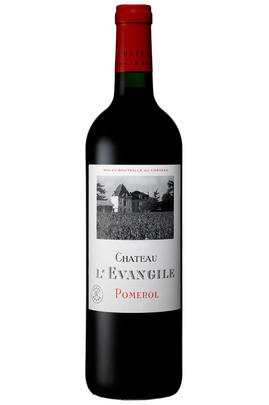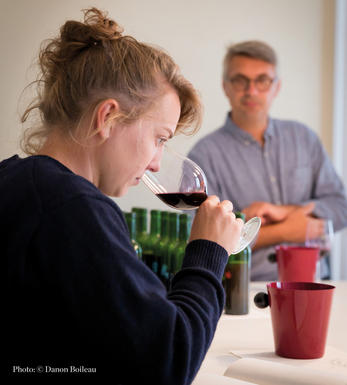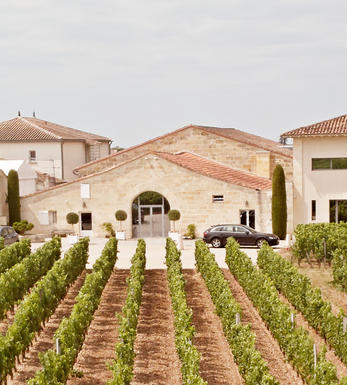
2022 Château l'Evangile, Pomerol, Bordeaux

Critics reviews
The 2022 L'Evangile was picked at 30hL/ha. It is aged in 50% new oak sourced from four coopers plus two recently introduced foudres. There are similarities with neighbouring Cheval Blanc on the nose, as if it's holding something back in a good way. Beautifully defined, dark berry fruit, crushed stone, and bay leaf aromas are succinct and not showy.
The palate is medium-bodied with a smooth, velvety entry. There's plenty of rondeur, nicely judged acidity, pliant tannins (more than Cheval Blanc?) and pure with a dab of white pepper and clove. Classic in style. A touch of desiccated orange rind appears on the aftertaste that was apparently there during the fermentation. Very harmonious on the finish.
This is a lovely, discrete Pomerol from an estate moving in the right direction - fast. 14.3% alcohol.
Drink 2030 - 2070
Neal Martin, Vinous.com (April 2023)
The 2022 L'Évangile is seriously impressive right out of the gate, dark, rich and enveloping. Dark-fleshed fruit, mocha, spice, leather and a kiss of new oak race across the palate. Texturally, the 2022 is gorgeous.
One of the recent changes here (since the 2021 vintage) has been a reduction of wine that undergoes malolactic in barrel from 100% down to 60-70%. More than anything, the 2022 impresses with its gorgeous inner sweetness and exceptional balance. In short, the 2022 is a classic Évangile.
Drink 2032 - 2062
Antonio Galloni, Vinous.com (April 2023)
Density combined with elegance, this has the intensity and spice of the vintage, with an emphasis on tight black fruits, a clear reflection of the phenolic concentration of the year, and slow and steady tannic construction that brings in graphite.
Unusually for L'Evangile, this feels almost Left Bank in character, with its 28hl/h yield (compared to 33hl/h in 2020 but with nearly 20% more berries this year, but they were such small sizes)—3.8ph 2nd year of organic certification.
Drink 2030 - 2048
Jane Anson, JaneAnson.com (May 2023)
Given the average young age of this estate's vineyards, its well-draining soils and the extreme vintage, I was a little apprehensive; but the technical team took the conditions in their stride, harvesting the east-facing side of the vines (which sees the hottest afternoon sun) four days earlier.
The resulting 2022 L'Evangile is beautiful, offering up aromas of raspberries, vine smoke, black truffles, violets and gravely soil. Medium to full-bodied, supple and velvety, it's seamless and polished, with a bright core of fruit and powdery tannins that temper 2022's inherent fruit sweetness to a sophisticated effect.
At this early stage, it appears that the estate's progress regarding élevage continues too, as Evangile's creamy oak signature is much released, allowing the fruit—and this superb terroir—to take centre stage. It's a blend of 82% Merlot, 17.5% Cabernet Franc and 0.5% Cabernet Sauvignon.
William Kelley, Wine Advocate (April 2023)
82% Merlot, 17.5% Cabernet Franc, 0.5% Cabernet Sauvignon. Cask sample.
Aromatically reticent, but there’s lift and a bit of freshness. Ample fruit on the palate and tannins that are smooth and long. A crunchy note adds to the persistence. Still a little wayward, but élevage should help.
Drink 2029 - 2040
James Lawther MW, JancisRobinson.com (May 2023)
Fresh, wonderfully refined, gorgeously polished, and long, with very fine tannins. Medium to full body. Crunchy fruit and chocolate, hazelnut and spice. Exciting to see how this tensioned beauty will evolve. Wonderful clarity.
James Suckling, JamesSuckling.com (April 2023)
Savoury notes on the nose, liquorice, cinnamon, spicy pepper with fragranced blackcurrant, black cherry, and strawberry. Appealing juiciness and fresh acidity, not at all sharp, but chalky, balanced by a sleek frame, giving power and concentration but refreshing too with a crisp, wet stone bite that immediately offsets the acidity and fruit intensity.
It doesn’t immediately shine out of the glass; this is more shy and calm. Definitely more straight and almost light in terms of expression (most of the power, opulence and oomph has gone into Blason), but this is extremely well made. So well constructed and delivered, just toned down, less shouty, more sophisticated, one to watch and will age wonderfully.
3.82pH. Ageing 10% foudre, 15% amphora, 50% new oak and the rest in one-year barrels. A yield of 28hl/ha. Harvest 29 August - 14 September.
Drink 2029 - 2050
Georgina Hindle, Decanter.com (April 2023)
The Grand Vin checks in as 82% Merlot, 17.5% Cabernet Franc, and a splash of Cabernet Sauvignon brought up in 50% new oak, 15% in amphora, 10% in foudre, and the rest in used barrels. It has another level of purity and class, with ripe red and black cherries, leafy herbs, truffles, and spice-driven aromatics.
These carry to a medium to full-bodied Pomerol offering beautiful tannins, a silky, elegant mouthfeel, and a great finish. Hitting 14.2% alcohol, with a pH of 3.84 and an IPT of 75, this classy, balanced Pomerol shines for its purity and finesse, and it should blossom with just short-term cellaring.
Jeb Dunnuck, JebDunnuck.com (May 2023)
About this WINE

Chateau l'Evangile
Château L'Evangile is one of the prestigious estates in Pomerol and produces some of the most sought-after wines in the appellation. It is located in the far east of the Pomerol appellation and its vineyards border those of Château La Conseillante, Château Gazin and Château Cheval Blanc. Its 14.1 hectares of vineyards (Merlot 78%; Cabernet Franc 22%) lie on deep gravel beds pitted with sand and clay.
The wine is vinified traditionally, undergoing a lengthy cuvaison followed by maturation in oak barriques (40% new) for 16-20 months. L`Evangile has always been a top-class estate but quality has been pushed noticeably higher since Domaines Baron de Rothschild of Château Lafite acquired a majority shareholding in 1990.
With Michel Rolland as consultant winemaker, the wines of L'Evangile are now challenging Pétrus and Lafleur in terms of their sheer class and quality.

Pomerol
Pomerol is the smallest of Bordeaux's major appellations, with about 150 producers and approximately 740 hectares of vineyards. It is home to many bijou domaines, many of which produce little more than 1,000 cases per annum.
Both the topography and architecture of the region is unremarkable, but the style of the wines is most individual. The finest vineyards are planted on a seam of rich clay which extends across the gently-elevated plateau of Pomerol, which runs from the north-eastern boundary of St Emilion. On the sides of the plateau, the soil becomes sandier and the wines lighter.
There is one satellite region to the immediate north, Lalande-de-Pomerol whose wines are stylistically very similar, if sometimes lacking the finesse of its neighbour. There has never been a classification of Pomerol wines.
Recommended Châteaux : Ch. Pétrus, Vieux Ch. Certan, Le Pin, Ch. L’Eglise-Clinet, Ch. La Conseillante, Ch. L’Evangile, Ch. Lafleur, Trotanoy, Ch. Nenin, Ch. Beauregard, Ch. Feytit-Clinet, Le Gay.

Merlot
The most widely planted grape in Bordeaux and a grape that has been on a relentless expansion drive throughout the world in the last decade. Merlot is adaptable to most soils and is relatively simple to cultivate. It is a vigorous naturally high yielding grape that requires savage pruning - over-cropped Merlot-based wines are dilute and bland. It is also vital to pick at optimum ripeness as Merlot can quickly lose its varietal characteristics if harvested overripe.
In St.Emilion and Pomerol it withstands the moist clay rich soils far better than Cabernet grapes, and at it best produces opulently rich, plummy clarets with succulent fruitcake-like nuances. Le Pin, Pétrus and Clinet are examples of hedonistically rich Merlot wines at their very best. It also plays a key supporting role in filling out the middle palate of the Cabernet-dominated wines of the Médoc and Graves.
Merlot is now grown in virtually all wine growing countries and is particularly successful in California, Chile and Northern Italy.


Buying options
Add to wishlist
Description
This is one of the best Pomerols of the vintage. Yields were down to 30hl/ha. The sense of purpose and progress under the new regime continues here. While there is restraint, there are also sensational aromas of perfumed blue fruit and violets.
The palate is elegant, very well integrated and with exceptional fruit purity. Creamy red-and-black cherries and suave, powdery tannins lead into a silky, concentrated finish. This is a real statement of class, with even better to come as the new plantings mature.
Alcohol is 14.2% but with excellent balance. This has enormous cellaring potential.
Merlot 82%; Cabernet Franc 17.5%; Cabernet Sauvignon 0.2%
Drink 2028 - 2050
Berry Bros. & Rudd (April 2023)
wine at a glance
Delivery and quality guarantee